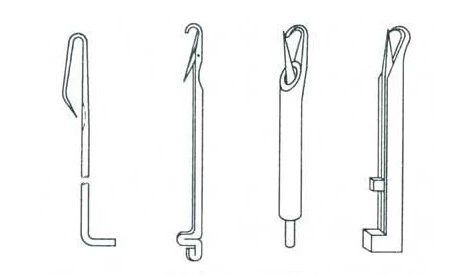Needle Lubrication and Resolutions for Oil Needle Issues
Jan 12, 2024
In the realm of textile manufacturing, circular knitting machines have long been sought-after products. Among them, the prominence of needles and their intricate lubrication systems plays a crucial role in ensuring the seamless operation and lifespan of these machines. This article aims to elucidate the principles of effective needle oil atomization in circular knitting machines, the essential checks required, oil supply regulation, and the prevention and handling of oil needle incidents.

Needle Oil Atomization
Efficient needle oil atomization necessitates thorough mixing of compressed air with needle oil inside the fuel tank. Damaged components, blockages, or insufficient gas can impact the oil and gas mixture, affecting lubrication. After entering the oil tube, pressure decay may temporarily separate oil and gas. However, they are forced into oil spray through pores on the glib, covering the cam track and needle surface evenly, reducing friction, minimizing vibration, and enhancing needle performance.
1. Checking Oil Atomization
To assess oil atomization, observe the glib when the machine is running. If there's an even oil film on the machine surface, the oil and gas ratio is suitable. If oil drops appear, it indicates either excessive oil supply or insufficient gas. The absence of an oil film suggests inadequate oil supply or excessive gas. Adjustments are necessary for optimal lubrication effects.
2. Oil Supply
Regulating oil supply involves adjusting the oil and gas mixing to achieve optimal atomization effects. Both oil and gas supplies should be adjusted simultaneously. After adjusting oil supply, recheck atomization to ensure the best lubrication effects.
3. Confirming Oil Supply
Oil supply is closely related to machine speed, yarn characteristics, fabric types, materials, and cleanliness. In well-conditioned workshops, proper oil supply minimizes machine-generated heat and prevents visible oil on fabric surfaces. A warm, not hot, machine surface after 24 hours of operation indicates appropriate oil supply. Otherwise, if the surface remains hot, the machine may be dirty or spinning too fast.

Oil Needle Causes and Processing
1. Oil Needle Causes
Abnormal oil supply or an imbalanced oil and gas ratio can lead to oil needle formation. Redundant oil drop flow or mixing with debris inside the cam track causes yellow or black oil needle on fabrics.
2. Oil Needle Prevention
Prevent oil needle by ensuring a reasonable oil supply, keeping the machine clean, and regulating oil supply during operation. Stop the machine if oil needle appears, check and clean the cam track, and replace needles if necessary. Emptying the machine for 10 minutes, especially with many modules or rough yarn counts, helps prevent oil needle due to high resistance. Normal or slightly excessive oil and gas supply during this process is crucial to avoid machine jams.

Needle Oil Atomization
Efficient needle oil atomization necessitates thorough mixing of compressed air with needle oil inside the fuel tank. Damaged components, blockages, or insufficient gas can impact the oil and gas mixture, affecting lubrication. After entering the oil tube, pressure decay may temporarily separate oil and gas. However, they are forced into oil spray through pores on the glib, covering the cam track and needle surface evenly, reducing friction, minimizing vibration, and enhancing needle performance.
1. Checking Oil Atomization
To assess oil atomization, observe the glib when the machine is running. If there's an even oil film on the machine surface, the oil and gas ratio is suitable. If oil drops appear, it indicates either excessive oil supply or insufficient gas. The absence of an oil film suggests inadequate oil supply or excessive gas. Adjustments are necessary for optimal lubrication effects.
2. Oil Supply
Regulating oil supply involves adjusting the oil and gas mixing to achieve optimal atomization effects. Both oil and gas supplies should be adjusted simultaneously. After adjusting oil supply, recheck atomization to ensure the best lubrication effects.
3. Confirming Oil Supply
Oil supply is closely related to machine speed, yarn characteristics, fabric types, materials, and cleanliness. In well-conditioned workshops, proper oil supply minimizes machine-generated heat and prevents visible oil on fabric surfaces. A warm, not hot, machine surface after 24 hours of operation indicates appropriate oil supply. Otherwise, if the surface remains hot, the machine may be dirty or spinning too fast.

Oil Needle Causes and Processing
1. Oil Needle Causes
Abnormal oil supply or an imbalanced oil and gas ratio can lead to oil needle formation. Redundant oil drop flow or mixing with debris inside the cam track causes yellow or black oil needle on fabrics.
2. Oil Needle Prevention
Prevent oil needle by ensuring a reasonable oil supply, keeping the machine clean, and regulating oil supply during operation. Stop the machine if oil needle appears, check and clean the cam track, and replace needles if necessary. Emptying the machine for 10 minutes, especially with many modules or rough yarn counts, helps prevent oil needle due to high resistance. Normal or slightly excessive oil and gas supply during this process is crucial to avoid machine jams.
Next: Addressing Defects in Dyed Fabric Production
Previous: Yuanda Double Jersey Circular Knitting Machines are Working for the Customer's Factory
About Us
We have been committed to manufacturing all types of circular knitting machines with great quality and reasonable price for a long time. Our professional team is highly specialized and problem-solving oriented. We put the most effort into meeting your knitting demands, achieving a win-win situation.
Categories
Useful Links
